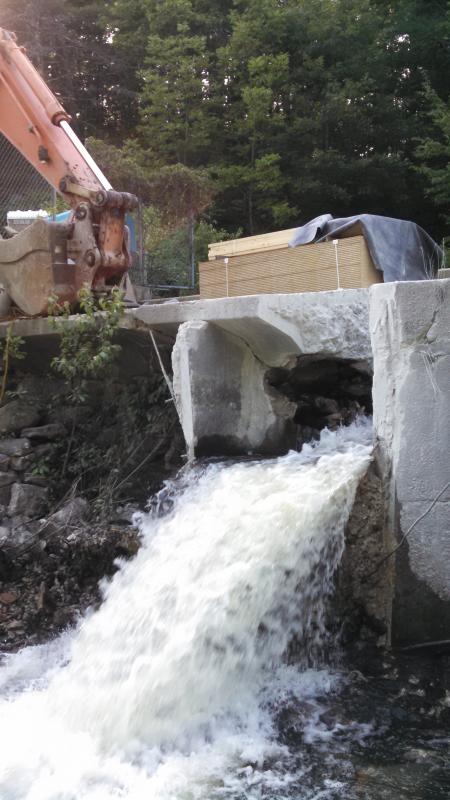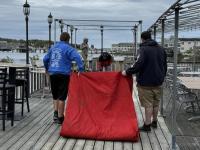New Nequasset Dam fish ladder under construction
Since 1955 the concrete fish ladder at Nequasset Dam has provided a way for migratory alewives to ascend from the salty tidal waters of the Sasanoa River to fresh water spawning habitat in Nequasset Lake. But after 57 years exposed to freezing and flooding conditions, the concrete ladder had badly deteriorated and needed replacement. Bath Water District, owner of the dam and ladder, worked with Kennebec Estuary Land Trust, Woolwich Fish Commission and state and federal fisheries agencies to design and raise funds for a new ladder so that the alewives could continue their historic journey to and from the sea.
For hundreds of years Native American and colonial inhabitants of this region have relied upon the alewife for food, and they arrived by the thousands in spring just when the food supplies were low after a long winter. Native Americans dried and smoked the fish to preserve it, and taught the first white settlers how to do the same for their own use. This practice continues today with the current harvester at Nequasset, Steve Bodge, who sells smoked alewives in late May, although few people still rely on them for nourishment.
The alewives were so important to the community for food and fishing bait that laws were created as early as the 1700s to protect the fish. All mills had to have passage chutes so that alewives could complete their spawning runs into the Lake. When the first dam was built, it too had to provide a passageway for the alewives. Additional laws throughout the 18th and 19th centuries further protected the life cycle of the alewives.
The fish are still are important economic contributor as lobster bait. In fact, Nequasset is one of fewer than twenty municipally-managed harvest sites in Maine, the only remaining state with a commercial alewife fishery. The alewife population has declined dramatically in recent decades due to overfishing, pollution and the loss of access to spawning habitat, which has been blocked by dams, culverts and development.
Since 2012 Kennebec Estuary Land Trust volunteers have conducted an annual count of fish that pass over the Nequasset Dam. In 2014 19,061 fish were counted, which estimates a run size of 268,310. In 2013 the run was estimated at 137,000; in 2012, 164,000 fish.
Construction is now underway and is expected to be complete by the end of August so that next spring the historic run of Nequasset alewives will ascend a new and more efficient ladder as part of completing their lifecycle. Through a competitive bid process, Atlantic Mechanical, Inc. of Woolwich was selected to perform the logistically complicated work of demolishing and replacing the fish ladder, without interfering with the migratory needs of the fish or disturbing the sensitive stream habitat.
This type of habitat restoration is critical to ensuring the survival of migratory fish species that spend most of their life at sea but return to fresh water lakes and ponds to spawn. Alewives are a keystone species in the Gulf of Maine food web and are eaten by many commercially desirable species like cod, hake and haddock.
Maine is a leader in river restoration projects like the one at Nequasset; beginning in 2000 with the removal of the Edwards Dam on the Kennebec River in Augusta, and continuing with the high profile restoration on the Penobscot River. On a smaller scale, there is a need for hundreds of culverts to be replaced so they can accommodate migratory species.
Work at Nequasset is funded in part by the Maine Coastal Program and Trout Unlimited in partnership with the National Oceanic and Atmospheric Administration. For questions or to request a tour of the site please contact the Kennebec Estuary Land Trust at 207-442-8400 or emailaheyburn@kennebecestuary.org.
Event Date
Address
United States





























